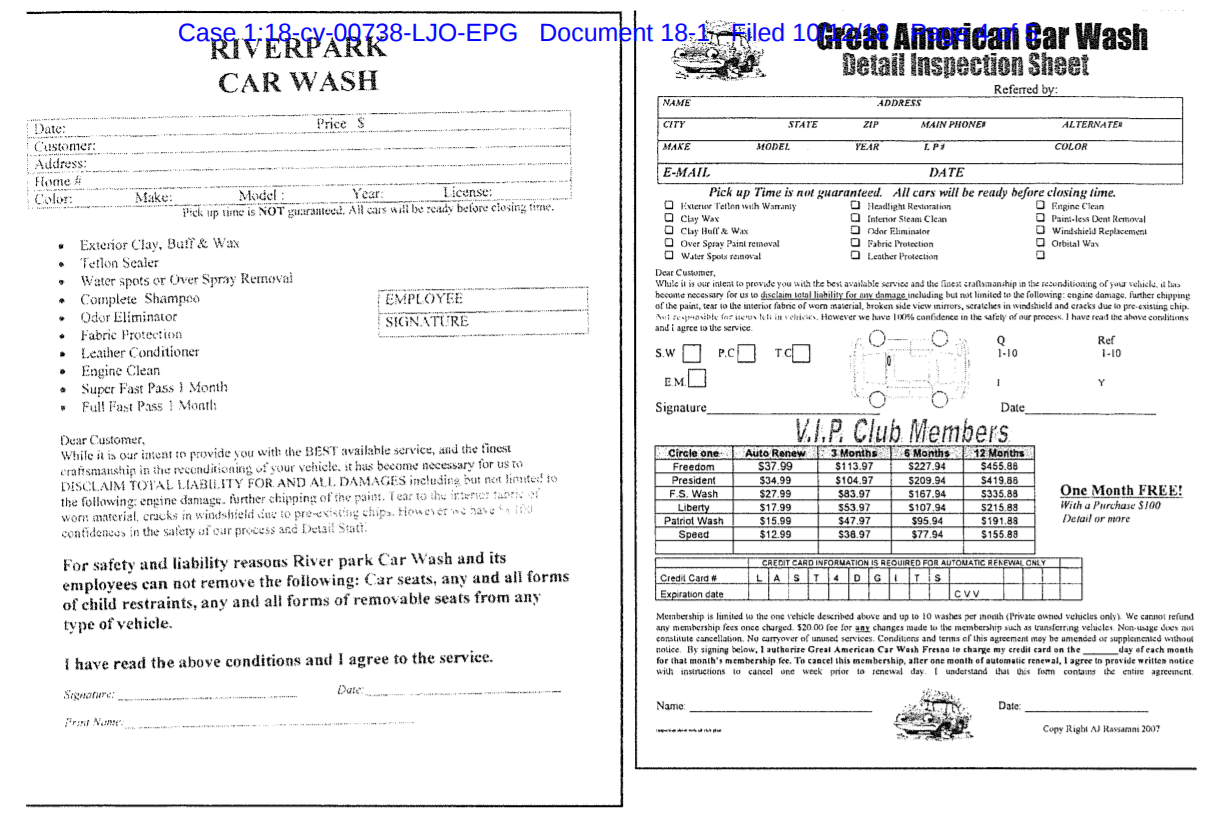Copyright May Protect a Car Wash’s Liability Disclaimer–Rassamni v. Fresno Auto Spa
A pretty interesting copyright dispute is brewing in unexpected circumstances: among rival car washes in Fresno. The plaintiff includes the following language in its brochure and inspection sheet:
Dear Customer, While it is our intent to provide you with the best available service and the finest craftsmanship in the reconditioning of your vehicle, it has become necessary for us to disclaim total liability for any damage including but not limited to the following: engine damage, further chipping of the paint, tear to the interior fabric of worn material,…However, we have 100% confidence in the safety of our process…
The defendant copied this language verbatim for its own inspection sheet. I doubt it consulted a lawyer before doing so. Had it done so, I expect most copyright experts would have approved the recycling based on the merger doctrine and the Morrisey case involving the copying of sweepstakes rules. While it would be possible to reword the liability disclaimer better, there are only so many ways to express the underlying concepts that (a) we try to do a good job, but (b) we’re not liable for any damage, including [list of concerns], but (c) we’re confident our process is safe.
Nevertheless, the plaintiff got a copyright registration for its brochure and sued the defendant for copyright infringement. First, really? Second, this should be an easy defense win, right…?
The court rejects the defendant’s motion to dismiss:
the Court cannot conclude from the pleadings alone that merger or scènes à faire apply. First, Defendants’ conclusion that a liability disclaimer can be expressed in only a few ways is unsubstantiated. It is not readily apparent from the FAC that there are sufficiently few means of expressing the ideas in the disclaimer such that the ideas and expressions merge, or that the language of a disclaimer is akin, in the legal profession, to a stock scene or character. Defendants offer no authority suggesting that disclaimers of this sort can only be crafted in one or two ways. Instead, Defendants attempt to shift the burden of showing that there are many ways of expressing the idea of a liability disclaimer onto Plaintiff. Once the presumption of copyrightability has been established by the existence of a copyright registration certificate, it is the burden of the party challenging copyrightability to show that an exception applies. Moreover, on a motion to dismiss under Rule 12(b)(6) the Court assumes the truth of well pled allegations and does not engage in factual determinations. There is a marked and conspicuous similarity in the two disclaimers, including word choice and phrasing, but it is not readily apparent from the compliant that the similarities are owed to the nature of a disclaimer.
Even if the Copyrighted Material is a functional work, or merger or scènes à faire applied, it is still entitled to thin protection. The Court cannot conclude as a matter of law that thin protection would not bar the alleged infringement. A reasonable finder of fact could conclude that the disclaimer of liability contained within Defendants’ form is virtually identical to its opposite number in the Copyrighted Material. Notable is the identical wording in the salutation and first sentence, the first clause of which is non-functional as a disclaimer in that it expresses in “advertising speech” the intention to provide excellent service. The only changes, apart from those mandated by the layout, are the alteration of the word “best” to all-caps, the addition in Defendants’ disclaimer of a comma between “service” and “and,” the replacement of underlining with all-caps and the deletion of the word “any” in the phrase “necessary for us to disclaim any and all damages,” and omissions to the list of specific types of damage for which liability is disclaimed. Defendants’ sheet also includes a bolded statement to the effect that car wash employees are not permitted to remove child seats or other child restraints. Therefore, even assuming that the Copyrighted Material is entitled only to “thin” copyright protection, Defendants’ motion to dismiss fails.
Ugh. There are some obvious problems here, including (1) the merger doctrine doesn’t require the defendant show that there are only “1 or 2” ways of expressing the idea; and (2) a work subject to the merger doctrine isn’t protected by a thin copyright, it loses its copyright protection altogether. I sure hope defense counsel helps the judge better under the merger doctrine sooner rather than later.
This case is also a good example of the problems with weaponizing thinly copyrighted works. The work in this case is essentially worthless as a copyright artifact, yet it will do a lot of damage before it’s dead.
More conceptually, the judge seems to valorize the copyright over the obvious competition problems lurking in this case. (Cf. one of my least favorite copyright cases of all time, the Webloyalty case). The brochure doesn’t cause any real competitive injury; so making this a federal copyright case is a huge waste of time and resources. In fact, if there’s any competitive injury here, it’s due to the maintenance of this dubious lawsuit designed to squelch competition. Perhaps the judge will address this concern later in the case, but he could have done everyone a favor by squashing this case early rather than letting it drain everyone’s coffers.
Case citation: Rassamni v. Fresno Auto Spa, Inc., 1:18-cv-00738-LJO-EPG (E.D. Cal. Feb. 11, 2019). The First Amended Complaint.

